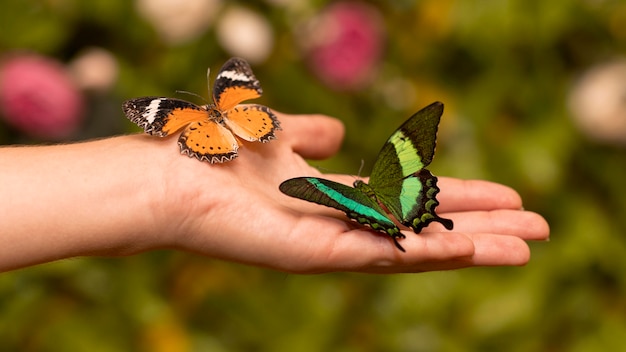Fascinating Facts About Butterflies

Butterflies come in thousands of different species and colors.
The smallest species of butterfly is the Pygmy Blue, with a wingspan of only half an inch.
Butterflies taste with their feet.
Monarch butterflies can travel up to 3,000 miles during their annual migration.
Butterflies have a specialized mouthpart called a proboscis that allows them to drink nectar.
A group of butterflies is called a flutter.
The largest species of butterfly is the Queen Alexandra’s Birdwing, with a wingspan of up to one foot.
Butterflies are insects, belonging to the order Lepidoptera.
Some butterflies, like the Luna Moth, have tails on their hindwings.
Butterflies are important pollinators for many plants.
Butterflies have a four-stage life cycle: egg, larva (caterpillar), pupa (chrysalis), and adult.
The average lifespan of a butterfly is only a few weeks.
Butterflies can see ultraviolet light, which helps them find nectar-rich flowers.
Some butterflies, like the Painted Lady, undertake long-distance migrations.
Butterflies rely on sunlight to warm their wings and become active.
The patterns on butterfly wings are made up of tiny scales that reflect light.
Butterflies have taste receptors on their feet to help them find food.
The only continent without native butterflies is Antarctica.
Some butterflies, like the Swallowtail, have false eyes on their wings to deter predators.
Fascinating Facts About Butterflies part 2
Butterflies develop through a process called metamorphosis.
The Tiger Swallowtail is one of the largest and most recognizable butterfly species in North America.
The top airspeed record for a butterfly is 12 miles per hour.
Butterflies can’t fly when their body temperature is below 86 degrees Fahrenheit.
Female butterflies are usually larger and live longer than males.
The Zebra Longwing butterfly can live up to nine months.
Butterflies can taste with their feet to determine if a leaf is suitable for egg-laying.
The first recorded butterfly observations date back to ancient Egypt.
Some butterflies, like the Glasswing, have transparent wings.
Butterflies primarily feed on nectar, but some species also feed on rotting fruit or carrion.
The Blue Morpho butterfly has iridescent blue wings that seem to change color as it moves.
Butterflies have a long and coiled tongue called a proboscis that allows them to suck up nectar.
Butterflies hibernate during the winter season to conserve energy.
The word butterfly comes from the Old English word buttorfleoge, meaning butterfly.
Many butterfly species, like the Monarch, utilize toxic plants to make themselves unappetizing to predators.
Butterflies have been featured in art and literature for centuries, symbolizing transformation and beauty.
The Oak Hairstreak butterfly is known for its unique habit of perching on oak trees.
Butterflies can’t fly during rainy or cloudy weather because their wings become too heavy.
The Red Admiral butterfly is known for its distinct red and black coloration.
Some butterflies, like the Painted Lady, are capable of long-distance flights across entire continents.
The long-tailed skipper butterfly has long, delicate, and wispy tails on its hindwings.
Swallowtail butterflies get their name from their swallow-like tails.
Some butterflies, like the Queen butterfly, closely resemble toxic species to ward off predators.
Butterflies have been used as symbols of hope, freedom, and transformation in various cultures.
A butterfly’s wings are made up of thousands of tiny scales, similar to a fish’s scales.
Butterflies are delicate creatures that bring joy and beauty to gardens and natural habitats.

